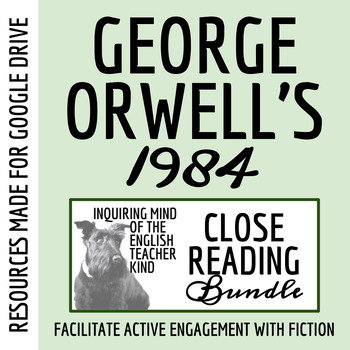1984 Close Reading Analysis Worksheets Bundle for Google Drive (Set of 24)
- Google Drive™ folder

Products in this Bundle (24)
showing 1-5 of 24 products
Also included in
- Evaluate reading comprehension, promote vocabulary development, reinforce close reading practices, and eliminate assessment planning responsibilities with this comprehensive bundle for teaching George Orwell's dystopian novel 1984. Included are 10 multiple choice quizzes, 10 short answer alternativePrice $63.00Original Price $85.00Save $22.00
Description
Help high school students go beyond general reading comprehension and support the development of critical thinking skills with this bundle of close reading analysis activities covering significant passages from George Orwell's dystopian novel 1984. Every chapter is represented for a total of 24 close reading worksheets. Materials are made for Google Drive, offering self-grading functionality and automated student feedback. (Alternatively, a printable bundle option is available.)
By engaging with these activities, students will:
- Identify what the text states explicitly and implicitly
- Define words and phrases as they are used in the text
- Verify interpretations of language using reference materials
- Choose the most proper application of words as they are used in sentences
- Discern the intended effects of the author's diction and narrative techniques
- Describe tone in context
- Determine the functions of given passages
- Explore how complex characters think, behave, interact, and develop
- Compare aspects of the Party's inner-workings to aspects of the Brotherhood's inner-workings
- Apply knowledge of literary devices including metaphor, simile, euphemism, symbolism, situational irony, and more
- Consider themes in context
- Conduct brief research on relevant topics, such as Nazi Germany's treatment of the Jews, and articulate historical parallels in the text
- Support claims and inferences with sound reasoning and relevant evidence
- Write about literature with clarity, accuracy, and precision
- Come to class better prepared to discuss works of fiction
This resource may facilitate small-group discussions in which students decode language and pose/respond to questions relating to plot, broad topics, and character development. Using this resource for structured guidance, students will improve their ability to present information, conclusions, and supporting textual evidence clearly and convincingly.
Resources are available for a variety of other engaging novels:
- 1984 by George Orwell - Google and printable
- Ender's Game by Orson Scott Card - Google and printable
- Frankenstein by Mary Shelley - Google and printable
- Feed by M.T. Anderson - Google and printable
- Life As We Knew It by Susan Beth Pfeffer - Google and printable
- The War of the Worlds by H.G. Wells - Google and printable






